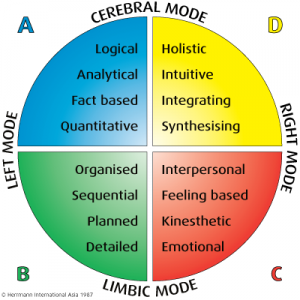Whole Brain Technology®
Herrmann International’s Whole Brain Technology®
As Herrmann’s preferred supplier in Malaysia, Papilio Novare is representing Herrmann International in Malaysia. (http://www.herrmannsolutions.asia)
What is Whole Brain Technology®?
Whole Brain Technology® is the art and science of understanding how individuals think. Whole Brain Technology® provides a basis for measuring different thinking preferences by determining the degree of dominance that has developed among four thinking styles. At the core of Whole Brain Technology® is the Herrmann Brain Dominance Instrument® (HBDI®)—the worldwide standard for measuring thinking preferences and brain dominance. Whole Brain Technology® is scientifically designed to help you and your people think better.
What are thinking preferences?
Thinking preferences have an impact on virtually everything we do, including communication, decision making, problem solving and managing styles. Understanding your thinking style preferences will give you a new perspective of yourself and people you deal with everyday.
What is the HBDI®?
The Herrmann Brain Dominance Instrument® (HBDI®) is the world’s leading thinking styles assessment tool. It identifies your preferred approach to emotional, analytical, structural and strategic thinking. It also provides individuals with a significantly increased level of personal understanding.
The HBDI® was developed by Ned Herrmann in the 1970s. Twenty years of research and innovation stand behind the validity of the HBDI®.
Over two-million people worldwide have undergone HBDI® analysis. It is used by over one third of all Fortune 100 companies.
The HBDI® is not just another assessment tool—it picks up where other assessment tools leave off.
Where most assessments end with a single report, the HBDI® offers a valuable range of applications. Identifying your thinking style preferences is only the first step.
How does it work?
The HBDI® identifies and measures the strength of preference for each of the four distinct thinking styles. These correspond to the cerebral hemispheres and the limbic system of the brain.
The two left side structures combine to represent what is popularly called left brain thinking. The two right side structures combine to represent right brain thinking. The two cerebral structures combine to represent cerebral thinking and the two limbic structures combine to represent limbic thinking.
The HBDI®, through its series of 120 questions, is capable of measuring the degree of preference between each of the four individual thinking structures (quadrants) and each of the four paired structures (modes). This results in a four quadrant profile, which displays the degree of preference for each of the four quadrants—your HBDI® Profile.
Scoring results are free of value judgement and cultural bias. Because it is a self-analysis, most people immediately recognise their results as accurate.
The HBDI® Profile package includes a full colour profile, accompanying interpretation booklets that explain the profile and scores in detail, and a discussion of the implications that your results have for business and personal life.
The HBDI® at work
The HBDI® is a tool for organisational development, leadership development, personal growth and innovation. It helps organisations to:
- improve individual and team effectiveness, productivity and communication
- increase creativity that will keep you light years ahead of your competition
- consequently increase performance and bottom-line results.
Once an individual or group has their HBDI® Profile, they are better able to understand their thinking styles and more importantly, the impact their thinking styles has on the way they learn, communicate and problem solve. Experience over the last 20 years has shown that individual and group applications of the HBDI® and Whole Brain Technology® are limitless.
Some specific business applications
Team effectiveness/Team cohesion
Encourage team building through a better understanding of individual thinking preferences and an exploration of how these thinking preferences impact behaviour, and ultimately team effectiveness. Understand and value what each individual brings to a team and the contributions they can make.
Composite one: homogeneous team
The chart shows that each member of this group (all are engineers) approaches problems and challenges with the same emphasis on correctness. They have their own ways of doing things, and they reject variations from set standards. The members are difficult to work with although the quality of their work is excellent.

Composite two: heterogeneous team
This group includes managers from information technology, the mail room, and the cafeteria. Although the members share such goals as an orientation toward quality, they have experienced a wide range of business problems. Members regard one another as resources, enjoy the group’s diversity, and take great pride in teamwork.
Career development
Increase job fit. Decrease turnover and job dissatisfaction. Scan for high- potential leaders and factor thinking preferences into their career paths.
Communication/Conflict resolution
Analyse your messages and their match to the thinking styles of your internal/external target audiences. Diversify and balance your communications to reach all audience segments. Reduce conflicts stemming from contrasting communication styles. Ensure effective communication with anyone, about anything, at any time.
Sales and marketing effectiveness
Apply thinking styles to shape market research, gain new insights into target markets and analyse trends. Factor customers’ tendencies and preferences into sales/negotiation methods.
Culture change/Organisational learning
Assess thinking styles across learning populations. Tailor learning to match learner preferences. Factor thinking styles into your strategies for managing culture change, mergers and acquisitions.
Strategy development
Map thinking styles of executives who shape strategy. Tailor strategy development process to turn differences from a liability into an advantage. Enhance clarity, confidence and consensus.
Creativity and innovation
Compose R&D groups, task forces and other groups to blend out-of-the-box thinkers and risk-takers with those demonstrating preferences toward analysis, planning and implementation.
How Can I Get The Whole Brain Advantage?
Contact us (info@papilionovare.com) for more information on Herrmann International and Whole Brain Technology®.


